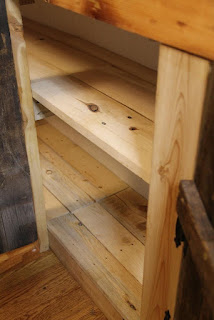 |
| The first thought we had was that the CaCO3 in the eggshells can be dissolved by the acetic acid in vinegar to make calcium acetate (Ca(Ac)2), which can be decomposed to CaCO3 around 400 °C. |
 |
| Unfortunately, some of the eggshell proteins are also apparently soluble in vinegar, and when we made calcium acetate by dissolving eggshells in vinegar and evaporating all the liquid, we ended up with a light-brown colored solid, which yielded a gray powder after a clean cycle in the oven (which gets close to 500 °C). We got a similar looking powder when we put ground whole eggshells through the oven clean cycle. |
 |
| The product from calcining eggshells in the rocket silo was actually a little darker colored. As a point of reference, we're looking for CaCO3 as a fine, white powder. |
This is actually a problem that's bothered us since we wrote about grinding up eggshells way back when this blog was just an infant. While it's usually possible to burn organic matter (e.g., proteins) off of inorganic residue (e.g., wood ash, glass, stainless steel) at 400-500 °C (750-930 °F), eggshells hold on to the organic matter from their protein until 900 °C (1650 °F). Unfortunately, at that temperature, our desired CaCO3 has transformed into lime (calcium oxide, CaO). Thus, it's no surprise that when we put a pile of eggshells in our oven and set it to the clean cycle, our pile came back grayish-colored instead of the white color of pure CaCO3. (Although, we were surprised at the time since we hadn't done much reading on the topic!)
So, we're 0-for-2 on getting our pure CaCO3 out of the eggshells at this point, but it's worth noting two things. First, while we haven't been able to get pure CaCO3 from eggshells, the gray powders from either the decomposed eggshells or the decomposed calcium acetate react much more vigorously with vinegar than the raw eggshells. Still not as vigorously as baking soda as the video below shows, but bubbles abound nonetheless. So, maybe the gray powders are worth trying as leavening.
Second, can we approximate a best-case scenario for obtaining pure CaCO3 from eggshells? Yes! We can get a bag of pure CaCO3 for a couple bucks at the local homebrew store. So while our blog post declaring victory on purifying CaCO3 from eggshells will have to wait until another day, we can still see what a best-case scenario for eggshell-based leavening would look like. Biscuit baking time!
 |
| Same recipe as last time, but only four sets this time: no leavening, gray CaCO3 from eggshells, white CaCO3 from the homebrew store, and NaHCO3 (baking soda). Very similar results as last time, too. The gray CaCO3 biscuits are definitely more risen than the no leavening control, and similar to the biscuits we baked last week from raw and lye-boiled eggshells. The white CaCO3 biscuits were noticeably more risen than the gray CaCO3 biscuits, but still couldn't hold a candle to the baking soda biscuits. |
 |
| The textures of both sets of CaCO3 biscuits were similar to last week's results, too. Not completely cooked through at the 20 min mark, while the baking soda biscuits were definitely done. |
Have you ever baked with eggshells or tried to isolate CaCO3 from them? How did it turn out?
EDIT: After going through our wood ash leavening experiments and realizing that we could get good leavening effect by incorporating more of the leavening agent, we came back and baked another set of biscuits with 1 tsp of the finely-ground eggshells (i.e., with quadruple the amount of eggshells of our recipe). The biscuits were definitely still not as light and fluffy as the baking soda-leavened biscuits, but were better than anything we had achieved so far, and actually, not too bad on texture. So, if you do any experimenting on your own, start with at least four times the volume of ground eggshells as the recipe calls for in baking soda (e.g., if the recipe calls for 1 tsp baking soda, use at least 4 tsp ground eggshells).


















































